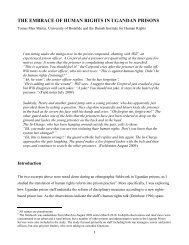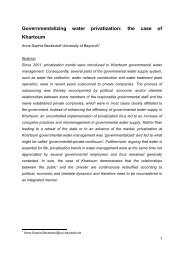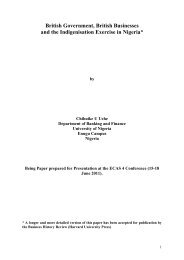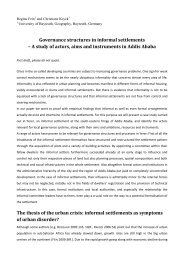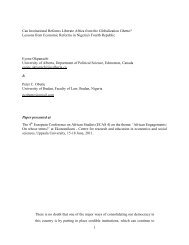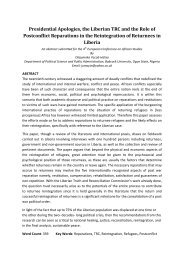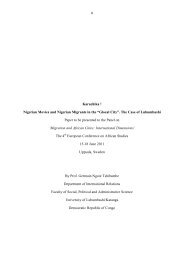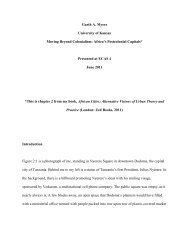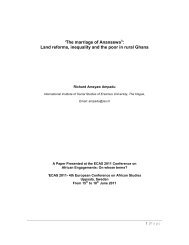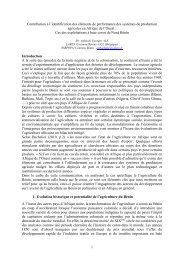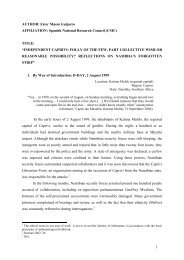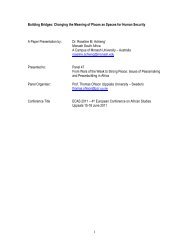Evam Kofi Glover - The Nordic Africa Institute
Evam Kofi Glover - The Nordic Africa Institute
Evam Kofi Glover - The Nordic Africa Institute
Create successful ePaper yourself
Turn your PDF publications into a flip-book with our unique Google optimized e-Paper software.
JUGGLING STAKES IN THE JUMBLE: THE MAGIC OF MARITAL<br />
DECISION MAKING AMONG YOUNG URBAN ELITE FEMALES IN<br />
Introduction<br />
GHANA<br />
<strong>Evam</strong> <strong>Kofi</strong> <strong>Glover</strong><br />
Two principal and conflicting arguments have been advanced in the literature concerning<br />
the trends of polygyny in <strong>Africa</strong>. On the one hand, there are those who see a decline of<br />
polygyny at least in the more urban environments of <strong>Africa</strong>. Modernization theorists for<br />
example, have largely alluded to the end of polygyny as society develops. Goode‟s<br />
(1963:187) i assertion is a classic reference point. He noted: “Women‟s increasing<br />
freedom of choice and the gradual shift from subsistence agricultural economy to a<br />
market or industrial one has meant a steady decline in polygyny”. It could be inferred that<br />
as females become free in choosing their mates as well as better economic prospects<br />
through formal education and professions outside the home avail for them, monogamy at<br />
the expense of polygyny - at least among elites - becomes the norm. Goode (1963) further<br />
argues; „In <strong>Africa</strong>‟s urban industrial areas, polygyny has become relatively rare: … urban<br />
life confers on the women none of the benefits that polygyny has in tribal areas‟ (p.188).<br />
Confirming this, Caldwell (1967) noted; “the physical family does in fact encounter<br />
many problems in town, especially, physical and economic problems… the fact that<br />
wives are willing to enter into polygynous marriage shows that they are not educated<br />
enough to earn the kind of wages as paid in town for professional or skilled work”<br />
(Caldwell, 1967: p.178). This throws us back to the old supposition that polygyny is a<br />
function of low education and the comparative maladjustment of the female in the<br />
modern economic system in <strong>Africa</strong>. From this perspective, decline in polygyny in the<br />
urban societies of <strong>Africa</strong> is expected as a natural consequence of changing aspirations,<br />
educational status and economic prospects of the female. Such trends are associated with<br />
accepting “the norms and practices governing modern life-styles, and, specifically, those<br />
affecting familial relations, than they would be in a rural context” (Clignet and Sween<br />
1974). ii<br />
1
It could be expected therefore that when elites make decisions about marriage, higher educated<br />
and economically independent females including those in white-collar occupations in the urban<br />
society constituting “… an important and salient reference group and model of modern-life-styles<br />
and behavior for other women” (Dinan 1983) iii would be inclined towards monogamy rather than<br />
polygyny (Omari, 1962; Tetteh, 1967; Caldwell, 1967; Oppong, 1982) iv . <strong>The</strong> most obvious<br />
question that arises from this stance is whether with romantic love leading to monogamy as the<br />
ideology, polygyny has disappeared among educated, professional and economically sound elites<br />
in Ghana.<br />
<strong>The</strong> second school of thought joins the debate at its weakest point. Proponents argue that<br />
polygyny in <strong>Africa</strong>n cities may not be declining as argued but has rather metamorphosed to fit the<br />
demands of the urban environment (Locoh, 1994; Mann, 1994; Karanja, 1987; Obbo, 1987;<br />
Clignet, 1987; Notermans, 2002) v . Making a clear distinction of the phenomenon between rural<br />
and urban environments in <strong>Africa</strong>, Karanja (1994) observes that “…reports, especially from the<br />
urban areas in many countries, indicate that people have opted for a different type of polygyny,<br />
private polygyny, which they perceive as being more in consonance with their perceptions of<br />
modernity”.<br />
At the core of the debate is whether the urban society has traces of polygynous marriages among<br />
the elites; if they do - when, why and how – become legitimate questions. While the debate over<br />
polygyny is echoed time and again in the literature, it is interesting that the process of decision<br />
making that leads to it seems to be glossed over. <strong>The</strong> question remains; when do elites transform<br />
or ignore social borders between monogamy and polygyny? Obviously there is little empirical<br />
work on social processes involved in border crossings between monogamy and social openings<br />
for polygyny among elites. This paper seeks to explore the decision making process of young<br />
urban elite 1 females in Ghana concerning type of marriage with focus on the processes that may<br />
lead to acceptance of polygyny. Specifically, the emphasis is on the complex arrangements,<br />
negotiations, and modifications by human players, within the specific material and cultural<br />
context of the city that determine border crossings between monogamy and polygyny among elite<br />
women.<br />
1<br />
<strong>The</strong> term “elite” refers here and hereafter to highly educated, members of the Ghanaian society: It includes<br />
Administrators, civil servants, professionals, university lecturers and the like.<br />
2
<strong>The</strong> Social Context<br />
<strong>The</strong> concept of urbanism as a way of life has dominated the argument against polygyny and its<br />
anticipated “eradication” especially among the elite. To Little (1974) vi for example, the concept<br />
of „urbanization‟ connotes „the process whereby people acquire material and non-material<br />
elements of culture, behavior patterns and ideas that originate in or are distinctive of the city.‟<br />
Indeed the complex social and economic influences of urbanization that historically manifested<br />
through colonialism, industrialization and globalization have variously been noted to have<br />
affected the family institution in Ghana in diverse ways. <strong>The</strong>se effects are generally expected to<br />
alter familial systems in the direction of monogamous arrangements.<br />
In the context of the city (synonymous with the urban environment) in Ghana, higher education<br />
is significantly the major determinant for potential social mobility. <strong>The</strong> city becomes the symbol<br />
of emancipation and for individual agency in achieving objectives. In this spirit, the challenges<br />
of cultural control in the traditional notion of division of labor between males and females<br />
become fluid. Clark (2003) vii for example regards the city as the space within which the current<br />
realities experienced by younger generations intersect with the historical legacy of modes and<br />
categories of cultural production. In this sense, the city is a melting pot that produces a<br />
hybridized form of space in which the old, new and fluid cultural identities emerge, are<br />
negotiated or contested. <strong>The</strong> fluidity is manifest in the routine daily struggle of members to meet<br />
their diverse aspirations. <strong>The</strong> bottom line is supposedly measured by meritocracy - a system in<br />
which advancement is based on individual ability or achievement and not ascription. On daily<br />
basis therefore the question facing the young person is how she can envision a better life – career<br />
and family life trajectory - across the ambiguous terrain of the city where relations are sometimes<br />
transient and informal and where belonging is sometimes in question.<br />
In this bargain, employers seeking to maximize space in the global market demand human<br />
capital. Both males and females equally yoked, compete within market imperatives that award<br />
performance by technical competence. However, historical and cultural realities for affirmative<br />
action and “equity”, especially for the ill-prepared segment of the population, are largely ignored.<br />
Glaring differential accessibility to resources especially between males and females over the years<br />
is manifest in this struggle where even within the family, some parents prefer to spend resources<br />
3
on male children at the expense of the female. With females lagging far behind and struggling to<br />
keep pace, questions of the relationship between economic capital and women‟s agency, as well<br />
as between varied paths for negotiating and inclusion of cultural identity-reinforcing reactions<br />
become crucial.<br />
Within this context therefore the trajectories of the emancipation and empowerment for females<br />
are yielding new values which spur new social development agenda involving the most profound<br />
interests of females. Certainly, female education, employment opportunities, status and<br />
empowerment are highly desirable objectives that should be pursued in their own right. <strong>The</strong><br />
International Conference on Population and Development (ICPD 1994) viii for example marked a<br />
turning point not only in the globalization of the movement for women‟s empowerment but also<br />
highlighting the sexual health challenges of especially adolescents in the developing world. In this<br />
context, human sexuality and gender relations, the definition of the family, and the inclusion of<br />
adolescents marked the paradigm shift towards the broader reproductive health approach.<br />
<strong>The</strong> declaration of the 1994 ICPD has facilitated series of subsequent activities towards practical<br />
implementations for removing the historical, social, cultural and economic layers of<br />
entanglements. <strong>The</strong>se fire expectations and new significations. <strong>The</strong> obvious first effects are seen<br />
in the role of many Non-Governmental Organizations (NGOs) that have effectively fought and<br />
won the debate over Female Genital Mutilation (FGM), promotion of girl-child education to the<br />
highest level, equal opportunities for both male and female in professional careers and political<br />
roles that were hitherto male dominated. Despite these strides, historical and cultural<br />
underpinnings create a lopsided reality in which females remain the most disadvantaged in efforts<br />
to achieve their aspirations (Caldwell, 1975; Bleek, 1987; Oppong, 2009) ix<br />
To overcome the structural hegemonies that hem them in, females learn to take every opportunity<br />
in creating space for themselves and to develop a large repertoire of approaches for manipulating,<br />
controlling, and creating the social capital needed to achieve individual objectives. <strong>The</strong> individual<br />
in such a context is not without agency. For Peter Leonard (1984) x this social reality provides the<br />
individual with choices and it is these choices that dictate the dialectic between the individual and<br />
social order. Thus, new orders are created as females work their way against the stiff walls<br />
historically created and maintained in the triple roles that until recently served as the boundary<br />
between males and females in the Ghanaian society.<br />
4
Indeed, with education becoming increasingly the main determinant for potential social mobility<br />
in Ghana, more and more females struggle in the competitive environment with their male<br />
counterparts to find placement in the new competitive order. Females are the most vulnerable in<br />
this competition where some parents prefer to support male children for higher education at the<br />
expense of the female. However it is important to indicate that a number of females accept this<br />
discrimination as “natural” and therefore feel helpless about making any efforts even where<br />
opportunity avails. As discussed by Thompson (1997), xi oppression or discrimination of this sort<br />
occurs at three levels: the personal level, the cultural level, and the structural level. Thompson<br />
argues that these three levels of oppression in dynamic interaction with each other reinforce and<br />
influence one another. We can only understand the situation by looking at it in a more holistic<br />
perspective because one‟s thoughts, attitudes, and behavior is a function of what happens in the<br />
larger context with these three levels interacting continuously with each other. With very limited<br />
sources of financial and moral support outside the immediate family therefore some females<br />
“…in town with meager or no resources of her own can avoid poverty by attaching herself to a<br />
well-to-do man” (Karanja 1994). <strong>The</strong> search for resources and young women‟s attempts at<br />
strategic allocation of their reproductive power has been observed to be widespread including<br />
among the highly educated. Karanja pointed out that “Some evidence suggests … women<br />
undergraduates, young professionals, secretaries, and the like are willing to attach themselves to<br />
men of means while they wait for the „right‟ man to come along” (Karanja 1994:201). But<br />
elsewhere Karanja (1987: 257-8) noted that some of these highly educated females cannot wait<br />
indefinitely for that ideal “right man to come along”. <strong>The</strong> ideal is tempered with social realities, a<br />
manifestation of “the potential tension between concepts and social practices” (Alber et al. 2006). In<br />
this sense, some choose “public polygyny” contracted under native law and custom. But why<br />
would an independent, economically capable, highly educated, professionally endowed female<br />
choose polygyny? Such a situation suggests that polygyny for the female may be more than just a<br />
function of economic survival. This expectedly raises into prominence two major questions posed<br />
by Mullaly (2002) xii : “Is the individual a relatively moral agent who is able to act on the<br />
surrounding world either to maintain or to change it? Or is the individual‟s sense of self, of<br />
identity and of autonomy a product of dominant structures and their supportive ideologies?” To<br />
Dinan (1983), the decision at the level of the individual choices goes beyond the individual per se<br />
and is rooted in the interconnection with the wider system of constraints and incentives present in<br />
the social environment. It is within this wider system that personality becomes crucial. <strong>The</strong><br />
5
individual exploits these interfaces based on attitudes that inform behavior as far as practices and<br />
ideologies, personal experiences and social discourse, human agency and social goals are<br />
concerned. How these crossing points play out in the personal experiences on the ground is a<br />
concern. It is within this context that the paradox of a shifting paradigm demonstrated by the re-<br />
emergence of polygyny in urban areas as strategies whereby young female elites juggle their<br />
stakes within the jumble of cultural and ideological hegemony become important. In this paper I<br />
take a contextual approach as a means of understanding the behavioral and cultural processes<br />
underlying the choice and acceptance of polygyny among some young female elites (those in<br />
white-collar occupations) in Ghana. <strong>The</strong> paper illustrates the decision making process leading to<br />
the choice of a genre of polygyny we shall call “neo-polygyny” 2 which in principle ignores the<br />
ideological hegemony established by the Church. <strong>The</strong> paper is based on fieldwork in Tamale,<br />
Bolgatanga-Navrongo and Sunyani cities 3 in Ghana between May and November 2010.<br />
Empirical data generated through life histories, focus group discussions, and interviews with<br />
young female elites is presented to provide insights into the interplay between social capital,<br />
economic capital and the decision making process regarding neo-polygyny among educated<br />
female elites.<br />
John Fisher's transition curve – the stages of personal transition applied to neo-polygyny<br />
John Fisher's (2005) xiii model of personal change - <strong>The</strong> Transition Curve - is an analytical model<br />
for explaining how individuals deal with personal change. My adaptation of the model to explain<br />
the process of decision making related to neo-polygyny however goes beyond the psychological<br />
into illustrating the complex context involving individual characteristics, social factors, and other<br />
psychosocial resources that may bear on the individual as a member of her society and how these<br />
contribute to marital outcomes either directly or indirectly. <strong>The</strong> framework helps us to visualize<br />
the process of decision making about neo-polygyny among female elites and the crucial threshold<br />
in this process.<br />
2 <strong>The</strong> word neo-polygyny is coined to reflect characteristics that make the phenomenon in the urban environment quite distinct from polygyny as<br />
pertains in the rural, agrarian, predominantly illiterate environment in Ghana.<br />
3 <strong>The</strong>se are capitals of Regions in Ghana known to have the highest rates of polygyny. <strong>The</strong> Ghana Demographic and Health Survey (GDHS) 1998<br />
reports that in the Upper West Region of Ghana, 35% of the sample of female respondents (15-49years) was married into polygynous union; in<br />
2003 it reduced to 40% and further reduced to 37% (GDHS 2008). In the Upper East Region it was 36% (GDHS 1998): 45% (GDHS 2003) and<br />
32% (GDHS 2008). In the Northern Region it was 52% (GDHS 1998), 44% (GDHS 2003) and 38% (GDHS 2008). And in Brong-Ahafo Region,<br />
Brong-Ahafo : it was 18% (GDHS 2003) and 11% by 2008.<br />
6
Exploring the Framework (John Fisher's transition curve adapted for the decision making process<br />
for neo-polygyny)<br />
What<br />
choices?<br />
Anxiety<br />
(Age after 25<br />
•Stereotypes<br />
•Dominant<br />
discourse<br />
Marketting<br />
strategies<br />
•exploration<br />
•Adventuree<br />
seeking behaviour<br />
•Resource seeking<br />
opportunities<br />
•Self esteem<br />
•Looking-glass-self<br />
•Peer influence<br />
•Perception of sex<br />
•Perception /use of<br />
modern<br />
contraceptives<br />
•RELIGIOSITY?<br />
Assumption: <strong>The</strong> dominant discourse -<br />
having babies within marital union<br />
Anxiety<br />
PROCESS OF TRANSFORMATION<br />
Apprehensions<br />
•SWOT Analysis<br />
•Has he got a<br />
girlfriend/fiance/wi<br />
fe?<br />
•Why has he not?<br />
•What are my<br />
prospects?<br />
•What strategies<br />
do I use?<br />
Terminate<br />
relationship<br />
Decision<br />
making<br />
threshold<br />
.HIV Test<br />
.Qualities of<br />
the man<br />
.<strong>The</strong> critical<br />
Question or<br />
Pregnancy<br />
•PREMEH<br />
•AGE<br />
•Peer<br />
pressure<br />
7<br />
Fulfilment of perceived<br />
societal goals<br />
Woman‘s<br />
agency<br />
Depression<br />
•Ideals and<br />
the self<br />
•<strong>The</strong><br />
society<br />
Neo- Polygyny<br />
Transformative<br />
learning and<br />
adaption to<br />
perceived<br />
key societal<br />
expectations<br />
Fisher (2005) believes that Anxiety occurs when there is an awareness that events lie outside<br />
one's range of understanding or control. Applied to the context of relationships and marriage,<br />
anxiety may connote the relationship between desire and reality. Desires may be aspirations<br />
designed with or without socio-cultural boundaries in mind. Even though one may have absolute<br />
control over the design, anxiety emerges with the fact that one may not always have absolute<br />
control over the implementation of the project as far as social factors are involved – undoubtedly<br />
social factors are the most variable of all variables. Interviews with young unmarried female<br />
elites (university graduates) reveal that the major concern is not so much whether one desires<br />
marriage or spinsterhood (that is given) but rather anxiety relates to when, who and how to<br />
identify as the “right” suitor for marriage. <strong>The</strong> general consensus was that marriage and child<br />
birth are crucial as members of the family, for one‟s own fulfillment, dignity and a great booster<br />
to the ego. This is how some of them put it:
For me, marriage and having children is the ultimate after the toils with<br />
academic certificate or job placement. It is perhaps the greatest<br />
expectation that crowns all endeavors. It makes you feel complete. But it<br />
is the timing that makes you anxious. (Nana Ama: 26-year-old civil<br />
servant).<br />
It is not like you have a choice anyway (marriage and child birth)… it is<br />
as it is…but some girls may delay marriage so as to be more prepared …<br />
thorough and careful in making the right choice. It is a struggle -<br />
disappointments and false steps here and there. One is always reminded<br />
that it must be done…and done within some time frame. That is what<br />
makes you anxious…(Efia 28-year-old National Service Person)<br />
People persistently put you on the edge … so much restlessness. Relatives,<br />
friends, colleagues, neighbors and even strangers that have very short<br />
acquaintance may pose the question within greetings… but they mean well<br />
… after all, no one wants you to live in perpetual pity, ridicule and<br />
suspicion? Marriage is fulfilling, and adds to our self-respect, wholeness<br />
and self-esteem as capable members of the family… (Zina, 26-year-old<br />
Banker)<br />
Discussions show that young adults face the challenge of forming identity distinct from their<br />
parents, grappling with gender issues and emerging sexuality, and making decisions for the first<br />
time in their lives. A thorny issue for some has been related to the relationship between resource<br />
needs at late adolescence and a female‟s agency and attempts at romantic love and courtship. For<br />
many young ladies, the strategic allocation of their sexual power as a tool for sustenance brings a<br />
lot of dilemma in later years. In their years of schooling, many had to balance their lives<br />
dexterously between two main sexual partners at the same time (the fact expertly hidden from<br />
any of the two males). It is a popular situation described as “Mr. Otua” (one who pays the bills)<br />
and “Mr. Odi” (one who benefits without contributing) or the “baboon dey work, monkey dey<br />
chop” syndrome. “Mr. Odi” is usually an age mate (perhaps a fellow student or worker who is<br />
resource strapped but a young man with great prospects for the future) seen principally as<br />
marriageable and occupies the privileged status and pampered at the expense of an older man –<br />
“Mr. Otua” (who is “milked” for resources to sponsor one‟s lifestyle, and service bills including<br />
school fees, and accommodation). <strong>The</strong> challenge is how to keep both from realizing the game.<br />
8
As long as she is able to do this, she may have a sponsor for many years until at her discretion<br />
she could discard him conveniently for “Mr. Odi”.<br />
<strong>The</strong> impact is largely dependent on background characteristics including religiosity, family<br />
influence, urban/rural residence, educational level of parents, locus of control, and personal<br />
factors. <strong>The</strong> major concern for many of the young adults I interviewed is the question: What<br />
choices do I have? Studies show that in Ghana, sexual transitions frequently occur early – even<br />
before age 15 – but commonly by age 18 (<strong>Glover</strong> et. al, 1997; 1998; 2003; GDHS, 2008,) xiv . But<br />
adolescence is the critical stage when the individual discovers that she/he is biologically mature<br />
to have sex and to be pregnant/make a female pregnant and yet, she/he may not be socially<br />
mature (accepted) to do same because of the norms guarding sex and the social institution of<br />
marriage. It is a period of anxiety because of indecision, fear, inner conflicts, guilt, and agitations<br />
within and without.<br />
In this context, ambivalence and ambiguity brings a level of anxiety especially as young females<br />
elites set out to create private space, to assert themselves and to redefine the role of hegemonic<br />
control in their lives. Irrespective of background characteristics (religiosity, family influence,<br />
urban/rural residence, educational level of parents, locus of control and personal factors), she<br />
might have explored platonic and/or sexual relationships without serious thoughts or<br />
considerations for marital partnerships. With such basic explorations a girl may draw closer to<br />
finalizing her script for a sexual partner or husband. <strong>The</strong> increasing exposure to the mass media<br />
including internet facilities in <strong>Africa</strong> enables the young to explore across spatial borders. Dating<br />
partners worldwide is just a click away. Peers, siblings, family members, the mass media,<br />
religious groups and social circumstances play very crucial roles in shaping and reshaping her<br />
ideals of a romantic partner. It is a dynamic data set which keeps changing with new personal<br />
discoveries.<br />
Marketing strategies: Exploration<br />
In the spirit of late adolescence, most young people venture out into the open market usually<br />
under the influence of peers and sometimes parental push. Both nature itself and the social<br />
structure come into concert to help her in this exploration of her life. Her development into<br />
womanhood and all the signs that create a new image and consciousness, the lissome grace of<br />
her young body, the aura of her image within her social milieu (looking-glass self) gradually<br />
9
gives some leeway for exploration. Discussions also suggest that during the senior years in<br />
tertiary institutions, relationship issues become a major focus for students. Subtle efforts are<br />
made to identify potential partners through joining discussion groups, campus fraternities,<br />
avenues for socializing – participation in blind-dates, inter-institution youth camp meetings for<br />
tertiary institutions across country, national youth camps across country, voluntary association<br />
meetings, and inter university games all give opportunities to shop around when one is<br />
interested. After graduation, other opportunities still avail but become more and more limited<br />
with time and age.<br />
<strong>The</strong> relevance of marriage is generally seen not just at the personal level but also at the social<br />
level. No matter the level of economic and social independence of the individual in Ghana,<br />
marriage remains for both male and female culturally prescribed. This basic normative<br />
prescription especially for the female to marry and have children irrespective of her economic<br />
and social status has been widely documented (Little, 1973; Dinan, 1983; Bleek, 1987) xv . My<br />
findings show that with the eradication of traditional markers like puberty rites for the distinction<br />
between childhood and adulthood in many societies in Ghana, age becomes the main milestone to<br />
gauge timing for marriage. By 24 years, anxiety emerges with ladies who have not married or<br />
have not yet started courtship for marriage. This social pressure is accelerated at all angles with<br />
the impression that childhood is over and adventure for fun or for economic interest (where they<br />
apply) should become secondary concerns or sought within courtship. In the city where the<br />
influence of extended family is weaker, the church plays a central role as family. It is the strong<br />
pressure group ardently seeking to marry off younger members at the least opportunity. Indeed it<br />
seems that an indicator of a progressive church is the number of weddings celebrated by the<br />
pastor. In some circles, it is like a business strategy - the more the weddings, the more the youth<br />
get attracted, the more the membership swells, and the more the financial contributions and also<br />
the sheer increase in membership which in turn enhance the income and status of the leadership.<br />
Youth are crucial building blocks for any church. <strong>The</strong>ir participation brings zeal and vibrancy.<br />
<strong>The</strong> church has become a central market place for exploration, an interested party in the<br />
investment into marriage and its central role in the marriage ceremonies. Religion may be very<br />
central in absorbing anxiety about how to choose a partner. Many depend on prophecies, prayer<br />
sessions, and “waiting on the Lord” to allay the anxiety at this time. Special prayer sessions for<br />
single older adolescents, regular retreat programmes for young adults across sister congregations,<br />
10
youth fellowships, and special messages targeting the youth are very common. In a number of<br />
cases, this pressure is carried even further where church members try “linking” potential couples.<br />
Word goes round and the elders, members of the women fellowship, men fellowship etc all focus<br />
on lending a hand. It is Sui generis, an impulsion beyond the individual yet binding on her and at<br />
every turn, she is reminded of the biological clock that a first pregnancy after 35 years is at-risk<br />
pregnancy.<br />
Others may adopt other strategies apart from religion like discotheques, parties and sports. This<br />
market has travelled away from betrothals, forced marriages and has put the individual at the<br />
helm of making choices. It is also against the background that issues like the campaign against<br />
FGM and early marriages have been replaced largely by strong inclinations towards higher<br />
education for girls, late marriage and the quest for individual choice and romantic love.<br />
In most cases, however, many young adults have done some homework of making a checklist for<br />
evaluating prospective partners. <strong>The</strong>se expectations depend largely on certain crucial background<br />
characteristics: her adventure seeking behaviour; resource seeking opportunities; self esteem;<br />
looking-glass-self; peer influence; parental influence, perception of sex; perception /use of<br />
modern contraceptives; and sometimes religiosity. Discussions suggest that these contribute to<br />
her ability to influence the market for her purpose. However, a number of females held that<br />
success in this market is sheer luck or principally “fateful”. <strong>The</strong>y observed that many smart, self<br />
assured, good mannered females end up with raw deals whiles the roughriders get the best deals<br />
in most cases.<br />
Apprehensions: opportunities and threats<br />
Goody‟s (1970) observation still holds in many circles and is a major cause for apprehension<br />
among many unmarried young elite females. Goody argues that with more education in <strong>Africa</strong><br />
the marriage market is squeezed because of the “...„rule of homogamy‟ or the „rule of assortative<br />
mating‟ nearly universal in its application, according to which “like marry like.” Simply put, the<br />
social norms of evaluation or eligibility determine who shall associate on intimate terms and who<br />
are likely to be acceptable as marriage partners.” (Goody, 1970)<br />
However it is important to note that in many West <strong>Africa</strong>n situations, the „rule of homogamy‟ is<br />
subject to gender interpretations and undertones and comparatively advantageous to the male.<br />
11
Discussions suggest that university graduate men marrying for the first time will, in all<br />
probability, prefer courting far younger and less educated females who may have prospects for<br />
higher education after marriage than their contemporaries - “already made female elites”. <strong>The</strong><br />
highly educated female on the other hand is limited and hedged in with a lot of cultural and<br />
normative restrictions. Her list features preference for age mates, contemporaries or men a little<br />
older (not younger), social status, placement, egalitarianism, and the willingness of the man to<br />
give some level of personal space, more autonomy and independence for her profession. But at<br />
her age unfortunately, most contemporaries within the age range may either already be married<br />
or prefer relationships with far younger and less educated females. <strong>The</strong> irony is that the double<br />
standards of the social norms of eligibility (in marriage) in Ghana frown upon marriage between<br />
a younger man and an older woman (culturally associated with levirate marriage), a more<br />
educated wife and a less educated man, sometimes even the type of profession of the woman<br />
over that of the man and religious differences. However, these considerations are mainly<br />
considered crucial at the entry point of marriage. After marriage, the advancement of the woman<br />
in further education, wealth, employment or acquired social status are generally credited with the<br />
husband‟s ingenuity and draws a lot of respect for the couples. Clearly, the educated female who<br />
wants to find a suitable suitor is aware that she should start her homework far earlier because<br />
“after playing the field for a while, they may find it difficult to find a suitable single man who<br />
will marry them” (Karanja, 1994: p.201).<br />
As opportunities open at work places, church, and other social gatherings, the major<br />
apprehensions during dating also relates to the locus of control and sometimes the differential<br />
meanings attached to exercising discipline and holding back of sex to ensure “commitment”.<br />
Discussions show that about 24 years of age, most ladies would want to be clear that dating is<br />
within courtship. <strong>The</strong>y are aware that both men and women do not have to court to get sex and<br />
therefore human agency creates the game of juggling stakes, negotiating and manipulating where<br />
necessary to draw the man into the bargaining game and to increase his loyalty. But the<br />
bargaining game is based on exchange in which each party tries to understand the strategic<br />
currents that run below the surface. Fundamental to this bargain is getting as much reliable<br />
knowledge about the goal of the partner, personal needs, fears, interests, and the influences from<br />
his peers or family. Clearly, relations are forged through gifts and personal favors mainly from<br />
the man and bring with them obligations and expectations. <strong>The</strong> challenge revolves around the<br />
12
eciprocation rule that we should repay, in kind, what another person has provided us whether we<br />
want it or not (Arvind, 1996) xvi . Thus “the obligation to receive reduces our ability to choose who<br />
we wish to be indebted to and puts the power in the hands of others” (Cialdini, 1993) xvii . Those<br />
who violate the reciprocity rule are seen as opportunistic. Many young ladies said there is<br />
immense pressure from their male partners to lower their standards by accepting to have sex as a<br />
sign of “love”. A young lady who plays the “hard-to-get” game for too long may risk being seen<br />
as an opportunist and abandoned by a suitor. Many females are in a dilemma as to how far to<br />
trust a man who pressurizes for sex outside “commitment” yet at the same time they are afraid of<br />
risking the man finding another female willing to succumb and keep him. Susan, a 25-year-old<br />
civil servant provides an overview of her strategies:<br />
Most guys start by seeking mild flirtations for fun, to exploit without<br />
commitment. <strong>The</strong>y often come with determination to control negotiations,<br />
and subtly or explicitly pushing towards sex. If I like him, my strategy has<br />
been to start with dropping hints and allowing small gestures here and<br />
there but hold back the ultimate (sex). Holding back is not only a strategy<br />
for buying time to know him better, but also getting to know him enough<br />
to allow thorough discussions related to mutual safety issues including<br />
HIV/AIDS concerns. I always want to play it safe but I don‟t want to<br />
sound too cautious. As the relationship develops, guys become<br />
preoccupied with showing their frustration especially under the influence<br />
of peers. I have witnessed such strategies like threats of finding or flirting<br />
with other girls to invent jealousy, posing ultimatums, and walking out to<br />
demonstrate their commitment to their goal. Because I have already taken<br />
steps to know my HIV status, the willingness on his part for mutual testing<br />
(rapid test-kit) is for me an important step towards commitment. After this<br />
assurance, even though I still hold to my objective, in the spirit of the<br />
game, I usually provide some slim concessions here and there to whet his<br />
appetite. But in all, it is the issue of self-esteem, conscious planning and<br />
listening into every sign, body language, and gestures that counts. Tact<br />
and devotion to love but also, of course, a little luck on your side until he<br />
gets committed… (Susan, 27-year-old civil servant).<br />
<strong>The</strong> concern over sexually transmitted infections especially HIV/AIDS add a lethal dimension to dating<br />
and sex. Many of the young female elites said it is one of the most threatening and challenging<br />
aspects of venturing out of one‟s comfort zone. <strong>The</strong> use of safer sex methods becomes crucial and<br />
many have mentioned consistent use of the condom. Hepatitis B vaccination and also Voluntary<br />
Testing of HIV privately at a pharmacy as noted by Susan is gradually becoming a common<br />
phenomenon among young elites who want to plan better. A number of charismatic churches also<br />
13
demand certification specifically for laboratory tests including pregnancy test, HIV/AIDS and<br />
sickle cell tests (to determine whether a person is a sickle cell carrier or has sickle cell disease)<br />
before courtship and wedding within the church. To avoid any embarrassment therefore,<br />
individual young adults may use the Rapid Testing kits privately first to know their status and<br />
then could be confident in coming to the open in repeating this at the laboratories when<br />
demanded by the church before courtship is announced. Conversely, some couples ignore the<br />
demands of the church prefer traditional marriage and/or court marriage with a pastor in<br />
attendance to bless the marriage at premises.<br />
Another major source of apprehension is the impression that men are as varied as they are<br />
unpredictable. <strong>The</strong>y come into the market in different shades: attached but single, married but<br />
seeking; ever-attached-never-married; divorced with children; divorced without children;<br />
widowed with children; widowed without children; never-attached-never-married ready for<br />
serious relationship (the ideal?); then there are the young floating singles. A lady‟s shopping<br />
list may never anticipate sufficiently what the market could offer. Whatever the combination; the<br />
individual is faced with some basic questions: Has he got a girlfriend/fiancé/wife? Why has he<br />
not? What are my prospects? What strategies do I use?<br />
Whatever avenues are used, the market square has its own caprices that shape the behavior of its<br />
clients. As one occupies herself with this project, one is wont to come across diverse experiences<br />
from friends and other colleagues who are either contemporaries or have passed the path before.<br />
<strong>The</strong> feeling of anticipation, testimonies gleaned from other colleagues and one‟s own experiences<br />
in the exploration exercise brings hope but also disappointments, opportunities and threats. But<br />
above all, it gives the feeling that something is being done about the project.<br />
What then is the crucial threshold in the decision making process?<br />
As familiarity grows, gifts especially from the male to the female are expected to become more<br />
regular (birthdays, Christmas gifts, valentine-day gifts etc) as part of showing love, promoting<br />
interest in graduation into exclusive relationship, and the point of making decisions about longer<br />
term commitment. <strong>The</strong>re is also peer pressure on many ladies to conform to some expectations.<br />
Courtship may be a very expensive venture for men especially because it is vested with symbols<br />
with often opposite meanings for males and females. In a sense, the expectations are so high that<br />
some females become more and more attached to older, well established men who could afford to<br />
cope in this “show of affection”. Discussions suggest that in such situations unmarried men on<br />
the other hand look away to find much younger females that they long to “nurture and mould to<br />
14
form”. <strong>The</strong> Ghanaian engagement with consumer culture has always been an issue and seems to<br />
have intensified, with the use of imported consumer goods from America, Europe and Asia,<br />
especially China. Consumer culture is a dominant way of expressing romantic love and of<br />
showing a man‟s largesse. His masculinity is enhanced through creating the aura of capability<br />
and therefore suitability for courtship and marriage.<br />
As noted, men come in varied forms. For this discussion the issue centers on men who claim they<br />
are “attached but single” or “married but seeking”. <strong>The</strong>y have a straight forward case of<br />
acknowledging problems in their relationships for which they are seeking a suitable single<br />
woman for courtship and marriage. Most of these would promise that divorce would soon be<br />
pursued with their legitimate partners and would encourage the new lady to accept and trust. This<br />
situation is also enforced inadvertently by some churches including the Roman Catholic Church<br />
that make divorce a long and very tedious process for members. Men who want may use this<br />
opportunity also to their advantage. <strong>The</strong> agency of the female comes into play in such situations<br />
where she decides on terminating the relationship or accepting what the man has to offer. Age of<br />
the female is a big factor and also the opportunity cost in losing this particular relationship if she<br />
is very much attuned feature decisively in her choice. Traditional marriage may then be<br />
performed under the pressure of the man or sometimes after pregnancy and child birth, it<br />
becomes apparent that the divorce of the first wife is either impossible or that the man would<br />
rather have both wives than divorce. <strong>The</strong> onus lies on the respective women drawn into a<br />
polygynous union to take the decision. <strong>The</strong>y have a choice though – drag him to court, stay away<br />
as single parents or gloss over and stay back in the relationship and bargain for the man to be<br />
“more responsible”. On the part of the women, the decision hinges on their respective volition<br />
defined by their own agency, to be or not to be.<br />
In other cases, and again depending on the respective underlying agency, both the girl and her<br />
already married lover may keep up appearances or just gloss over the fact of disclosure. This is<br />
especially the case with men on working transfer from the southern to the northern part of Ghana.<br />
<strong>The</strong>y may leave their families back in the south especially with the excuse of the northern sector<br />
being more deprived of good schools for children as well as being highly volatile, unsafe and a<br />
war-prone zone. Separation may also be enforced because of the challenges posed by<br />
professional engagements for women. In such matters, a professional woman needing some space<br />
may not move out with a husband who is on transfer to another city about ten hours drive away.<br />
15
A compromise is reached where the children stay with their mother as the father moves away on<br />
duty elsewhere. A schedule is then put in place for regular visits.<br />
In their new stations however, such men present themselves as largely available and are<br />
especially attracted to single elite females who may also, by choice, need romantic<br />
companionship with men of status and class. This man may fit into all the criteria (physical,<br />
social status, economic, and psychological) on the shopping list but certainly it is open secret that<br />
he fails in the critical criterion - he is married. However, it is she who decides on how far to<br />
compromise. As the relationship progresses, the agency of the female is called into play. She<br />
decides to keep the relationship going or terminate it when she deems it inappropriate for her<br />
purposes. If she loves the man, even though married to a far removed wife with no apparent<br />
threat, she may device ways and means to keep him interested and committed.<br />
In this bargain, testing for sexually transmitted diseases especially HIV testing and serostatus<br />
disclosure as HIV-prevention strategy between lovers produces some latent functions. It certainly<br />
takes away the glooming fear of the dreaded disease and may signal that condom use may be<br />
secondary if only against pregnancy. <strong>The</strong>re are certainly more convenient contraceptives other<br />
than the condom. <strong>The</strong> fact remains though that all the other methods, except withdrawal and<br />
vasectomy, are female controlled methods. Non-condom use after mutual serostatus disclosure<br />
seems to enforce sexual intercourse as a stake in trust, commitment and especially concerning the<br />
female being faithful (even though lopsided because the continuous faithfulness includes a third<br />
party – the legal wife of the man). Any avoidance of male methods of contraception in this<br />
relationship however puts the balance of power in the hands of the agency of the female. She<br />
decides on controlling for pregnancy and even timing pregnancy by choice. As the man is busy<br />
negotiating his masculinity and virility, the lady decides on how far to go (contraceptive pills,<br />
injectables, IUD, Norplant etc) to avoid the problem of sensitivity with the condom. Avoiding the<br />
use of condoms may be a desire for both. But the message is coded and could be taken for<br />
granted and that ambivalence fits the lady‟s discretion. If she desires and she becomes pregnant,<br />
the law jumps to protect her immediately. Ghana has a very progressive abortion law that puts the<br />
woman as the centre of the decision. 4 Thus the decision to abort when pregnant planned or<br />
4 <strong>The</strong> abortion law in Ghana, enacted in 1985, states that “an abortion performed by a qualified medical practitioner is legal if the pregnancy is the<br />
result of rape, incest or “defilement of a female idiot; if continuation of the pregnancy would risk the life of the woman or threaten her physical or<br />
mental health; or if there is a substantial risk the child would suffer from a serious physical abnormality”<br />
16
unplanned depends largely on such factors like age, peer influence, familial background, and her<br />
agency. <strong>The</strong> embarrassing saga of Dr Richard Anane, the Minister of Health in Ghana at the time<br />
having unprotected intercourse - an extra-marital affair - while attending an HIV conference is a<br />
popular test case. 5<br />
Depression<br />
For many elite women interviewed, the decision to accept and enter into a polygynous union is a very<br />
difficult one, and one that is taken with a lot of concerns including self-image, review of the ideals one<br />
had lived for and also facing peers. Acceptance of reality is very difficult especially when peers are not<br />
supportive. <strong>The</strong> opportunity cost in some cases is losing friends who think otherwise. If she decides to go<br />
on, she may encounter some depression against her own ideals, the looking-glass-self, and therefore her<br />
self-esteem. This phase is characterized by confusion. Individuals are uncertain as to what the<br />
future holds and how they can fit into the future "world". <strong>The</strong> challenge to their core sense of self<br />
leaves them with worries and sometimes a problem of identity and no clear vision of how to<br />
operate.<br />
<strong>The</strong> Woman’s agency<br />
Despite this state of mind, many women observed that it is just a phase and one‟s mental situation<br />
and happiness rather depends largely on the social environment and the support one gets from<br />
especially the man, one‟s own kin and parents, and friends. Discussions show also that some elite<br />
females are not very perturbed because they had prepared their minds sufficiently and also their<br />
close associates beforehand. In this sense, it is not a sudden event or accidental when significant<br />
others have already been given adequate time to come to terms with the relationship before the<br />
eventual marriage. Societal reaction to this marriage is also controlled through limited<br />
information provided about the man and his legal marriage. This is especially the case where the<br />
man is on work transfer in another city other than where his legally married wife resides. In such<br />
a case, the legal wife may not immediately be in the known and therefore for some time, no<br />
counter claims are expected to derail the formation of the new uterine family. <strong>The</strong> new family<br />
may enjoy a long respite that “legitimizes” and consolidates the claim to acceptance traditionally<br />
5 Dr. Richard Anane was the minister of health at the time and while attending an HIV conference he met and had unprotected<br />
intercourse with and impregnated Alexandra O'Brien in Washington D.C in February 2001.<br />
17
and by society. Even though the legally married wife has the option for divorce, she may choose<br />
to stay in the marriage for personal, professional space and therefore for her agency. <strong>The</strong> man-<br />
between the respective uterine families plays the role of a foreman. As a middleman, he naturally<br />
transfers a lot of autonomy to the respective women especially because of the schedules put in<br />
place for his visits and quality time for the respective uterine families. Jealousy between rivals is<br />
at its lowest ebb in the city especially because each uterine family is housed apart in its own<br />
apartment. Women in neo-polygynous relationships observe that the well being of members of<br />
the uterine family depends largely on the capability of the woman to manage the affairs of her<br />
small family. <strong>The</strong> husband‟s contribution may be crucial especially as a father figure to children,<br />
material provisions and legitimacy; but his status as a “visitor” should be appreciated to bring<br />
meaning and understanding to the marriage. Discussions also suggest that the well being of the<br />
family as a whole is dependent on the understanding of members about this fundamental issue<br />
and how they adapt their lives to managing this structure. <strong>The</strong>y noted that if managed well, the<br />
respective women and their respective uterine families gain more as subtle competition between<br />
them sets everyone busy and working hard to be better off. <strong>The</strong>y observed that contentment is<br />
also in the fulfillment of perceived key societal expectation –marriage and giving birth – and the<br />
individual objective of a wider locus of control, semi-autonomy, career pursuit, sometimes a<br />
better social life romantic life.<br />
Conclusion<br />
My findings suggest that competition for space in the modern economy is one major factor<br />
exerting influence on the marriage institution in Ghana. Females are equally yoked with their<br />
male counterparts – yet resources including money and time are comparatively difficult for<br />
females. Some have created avenues for meeting societal expectations that give room to neo-<br />
polygyny. John Fisher's transition curve adapted for explaining the decision making process for<br />
neo-polygyny have been used to illustrate how some individual elite females use neo-polygyny to<br />
meet both societal and personal needs. Clearly, female elites who choose neo-polygyny against<br />
the social current of monogamy do this consciously by counting the cost and making a bold<br />
choice.<br />
Discussions generally suggest that for the average young female elite, late adolescence may be<br />
crucial in the experience of a level of anxiety about decision making concerning marital issues.<br />
18
<strong>The</strong> social pressure and the forefront cultural goal of marriage and children seem to take<br />
precedence over all else: economic independence, professional attainments and educational<br />
status. As she races against the biological clock, an elite unmarried middle-aged female is faced<br />
with tough decisions of juggling her stakes in the jumble of societal expectations and control. <strong>The</strong><br />
challenges are enormous: the market of “eligibles” become very limited with age as the “rule of<br />
homogamy” throws her against the wall. As many men shy away from marrying middle aged,<br />
highly educated, professional, “successful” single women as first wives, she has a choice to<br />
remain single, become a single parent, or marry a man she loves but who is already married.<br />
Whatever avenues are used, the market square has its own caprices that shape the behavior of its<br />
customers. It is however agreed that in all, it is the female‟s agency and interest that largely<br />
prevails in this encounter. Her anticipated happiness may be calculated on her drive to fulfill<br />
perceived key societal expectations – marriage and giving birth – and the individual objective of<br />
a wider locus of control, semi-autonomy, career pursuit, the dream of a better social life as well<br />
as a better romantic life. Indeed neo-polygyny for a long time may continue to remain a fiercely<br />
debated issue in public discourse in Ghana, like in many other places in <strong>Africa</strong> - a conflict which<br />
stems from the social conventions and the dominant discourse – especially Christian doctrines<br />
and faith. To understand the ambivalent motivations and behavior related to neo-polygyny<br />
therefore, we need to go beyond the broad issues about city life and religion to explore the<br />
interfaces between practices and ideologies, between personal experiences and social discourse,<br />
between human agency and social goals as well as how these crossing points play out in the<br />
personal experiences on the ground.<br />
19
BIBLIOGRAPHY<br />
i Goode, W.J. (1963), World Revolution and Family Patterns (London: <strong>The</strong> Free Press).<br />
ii Clignet, R. and Sween, J. (1974). Urbanization, plural marriage, and family size in two <strong>Africa</strong>n cities. American Ethnologist, 1: 221–242.<br />
iii<br />
Dinan, Carmel (1983). Sugar daddies and gold-diggers: <strong>The</strong> white-collar single women in Accra. In: Oppong, C. (ed.). Female and Male in West<br />
<strong>Africa</strong>. London: George Allen & Unwin: 344-366.<br />
iv<br />
Omari, P. T. (1960). Changing attitudes of students in West <strong>Africa</strong>n society towards marriage and family relationships. British Journal of<br />
Sociology, 11: 197–210.<br />
Caldwell, J. C. (1967). Migration and urbanization. A study of contemporary Ghana. Some Aspects of Social Structure. Canberra: ANU Press.<br />
Oppong, C. (1982). Middle-class <strong>Africa</strong>n marriage. London: Allen & Unwin.<br />
v Locoh, <strong>The</strong>rese (1994), “Social Change and Marriage Arrangements: New Types of Union in Lome, Togo”, in Caroline Bledsoe and Gilles<br />
Pison (eds.), Nuptiality in Sub-Saharan <strong>Africa</strong>: Contemporary Anthropological and Demographic Perspectives (Clarendon Press. Oxford).<br />
Mann Kristin (1994), “<strong>The</strong> Historical Roots and Cultural Logic of Outside Marriage in Colonial Lagos”, in Caroline Bledsoe and Gilles Pison<br />
(eds.), Nuptiality in Sub-Saharan <strong>Africa</strong>: Contemporary Anthropological and Demographic Perspectives (Clarendon Press. Oxford).<br />
Karanja, W.W (1987), „”Outside Wives” and “Inside Wives” in Nigeria: A study of Changing Perceptions in Marriage‟, in D. Parkin and D.<br />
Nyamwaya (eds.), Transformations of <strong>Africa</strong>n Marriage (Manchester: Manchester University Press), 283-306.<br />
Obbo, C. (1987), „<strong>The</strong> Old and New in East <strong>Africa</strong>n Marriage‟, in D.Parkin and D. Nyamwaya, (eds.), Transformations of <strong>Africa</strong>n Marriage<br />
(Manchester: Manchester University Press), 263-80.<br />
Clignet, R. (1970), Many Wives, Many Powers: Authority and Power in Polygynous Families (Evanston, III.: Northwestern University Press).<br />
Karanja (1994), “<strong>The</strong> Phenomenon of „Outside Wives‟: Some Reflections on its possible Influence on Fertility”, in Caroline Bledsoe and Gilles<br />
Pison (eds.), Nuptiality in Sub-Saharan <strong>Africa</strong>: Contemporary Anthropological and Demographic Perspectives (Clarendon Press. Oxford).<br />
Notermans, C. (2002). “True Christianity without Dialogue: Women and Polygyny Debate in Cameroon”. Anthropos 97: 341-353<br />
vi Little, Kenneth (1974): Urbanization as a Social Process: An Essay on Movement and Change in Contemporary <strong>Africa</strong>. London and<br />
Boston: Routledge and Kegan Paul.<br />
vii Clark Jude, (2003): Urban culture: representation and experiences in/of urban space and culture. Agenda: No. 57<br />
viii United Nations. 1994. Report of the International Conference on Population and Development (Cairo, 5-13 September 1994). A/CONF.171/13.<br />
New York.<br />
ix Bleek, W. (1987). „Family and Family Planning in Southern Ghana‟, in C. Oppong (ed.), Sex Roles, Population and development in West <strong>Africa</strong><br />
(London: Heinemann Educational Books, Inc.)<br />
x Leonard, Peter. (1984). Personality and Ideology: Towards a Materialist Understanding of the Individual. London: Macmillan.<br />
xi Thompson, Neil. 1997. Anti-Discriminatory Practices, 2 nd edn. London: Macmillan.<br />
xii (Mullaly, Bob. (2002). Challenging Oppression: A Critical Social Work Approach. Oxford University Press).<br />
xiii Fisher J. M. (2005). A Time for change, Human Resource Development International Vol. 8:2 (2005), pp 257 – 264.<br />
xiv <strong>Glover</strong>, E. K., Bannerman, A., Nerquaye-Tetteh, J. and Arkhurst, S. 1997. Context and content of condom and abstinence: Negotiation among<br />
youth in Ghana. International Family Planning Perspectives. 13(1):21-25.<br />
<strong>Glover</strong>, E. K., Erulkar, A.S., and Nerquaye-Tetteh, J. 1998. Youth centers in Ghana: Assessment of the Planned Parenthood Association of Ghana<br />
Programme. International Family Planning Perspectives. 24 (2): 65-71.<br />
<strong>Glover</strong>, E. K., Bannerman, A., Pence, B.W., Jones, H.J., Miller, R., Weiss, E., and Nerquaye-Tetteh, J. 2003. Sexual health experiences of<br />
adolescents in three Ghanaian towns. International Family Planning Perspectives. 29(1): 32-40.<br />
Ghana Statistical Service. (2008). Ghana Demographic and Health Survey. Macro International, Inc.<br />
xv Little, K. (1973), <strong>Africa</strong>n Women in Towns: An Aspect of <strong>Africa</strong>‟s Social Revolution. Cambridge: Cambridge University Press, 249-76.<br />
Dinan, Carmel (1983). Sugar daddies and gold-diggers: <strong>The</strong> white-collar single women in Accra. In: Oppong, C. (ed.). Female and Male in West<br />
<strong>Africa</strong>. London: George Allen & Unwin: 344-366.<br />
Bleek. W. (1987). „Family and Family Planning in Southern Ghana‟, in C. Oppong (ed.), Sex Roles, Population and development in West <strong>Africa</strong><br />
(London: Heinemann Educational Books, Inc.)<br />
20
xvi Arvind Sharma (1996). Hinduism for Our Times. New Delhi: Oxford University Press.<br />
xvii Cialdini, Robert (1993). <strong>The</strong> Psychology of Persuasion by psychologist. William Morrow: New York<br />
21




